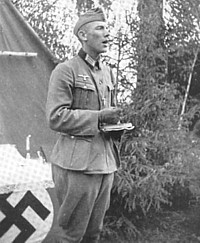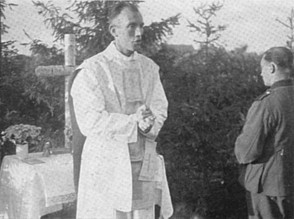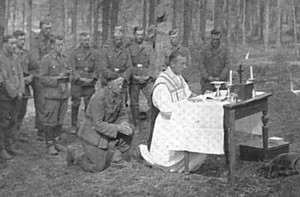[16] Ernst Tewes,
Seelsorger bei den Soldaten: Errinerungen an die Zeiten von 1940
bis 1945, Don Bosco Verlag, Munic: 1984, Pg 15.
[17] Conway,
John S. The Nazi Persecution of the Churches 1933-1945, New York: Basic
Books, Inc, 1968, pg. 125.
[18] Helmreich, German Churches, pg. 354.
[19] Helmreich, German Churches, pg. 359.
[20] Perau, Priester im Heere Hitlers, pg. 23.
[21] Lewy, The Catholic Church and Nazi Germany, pg.
309.
[22] Helmreich, German Churches, pg. 354.
[23] Doris Bergen, 'Germany is our Mission - Christ is our Strength'
The Wehrmacht Chaplaincy and the 'German Christian' Movement, Church
History, 66/3 (September 1997), 522-36, pg. 528
[24] Helmreich, German Churches, pg. 318
[25] Tewes, Seelsorger bei den Soldaten, pg. 84; Perau,
Priester im Heere Hitlers, pg. 203.
[26] Helmreich, [31] German Churches, pg. 185
[27] Conway, John S. The Nazi Persecution of the Churches 1933-1945,
pg. 129 & 136.
[28] Conway, John S. The Nazi Persecution of the Churches 1933-1945,
pg. 133.
[29] Doris Bergen,
Twisted Cross: The German Christian Movement in the Third Reich.
Chapel Hill: University of North Carolina Press, 1996, pg. 47.
[30] Doris Bergen, The Wehrmacht Chaplaincy and the 'German
Christian' Movement, pg.524
[31] Doris Bergen, The Wehrmacht Chaplaincy and the 'German
Christian' Movement, pg. 526 & 534
[32] Doris Bergen, The Wehrmacht Chaplaincy and the 'German
Christian' Movement, pg. 525.
[33] Perau, Priester im Heere Hitlers, pg. 26.
[34] Perau, Priester im Heere Hitlers, pg. 27.
[35] Perau, Priester im Heere Hitlers, pg. 27.
[36] Perau, Priester im Heere Hitlers, pg. 18 & 58.
[37] Lewy, The Catholic Church and Nazi Germany, pg.
241.
[38] Perau, Priester im Heere Hitlers, pg. 7
[39] Perau, Priester im Heere Hitlers, pg. 18.
[40] Perau, Priester im Heere Hitlers, pg. 8.
[41] Perau, Priester im Heere Hitlers, pg. 17.
[42] Perau, Priester im Heere Hitlers, pg. 12
[43] Perau, Priester im Heere Hitlers, pg. 9
[44] Perau, Priester im Heere Hitlers, pg. 11.
[45] Perau, Priester im Heere Hitlers, pg. 20.
[46] Perau, Priester im Heere Hitlers, pg. 32
[47] Perau, Priester im Heere Hitlers, pg. 14.
[48] Perau, Priester im Heere Hitlers, pg. 13.
[49] Perau, Priester im Heere Hitlers, pg. 20.
[50] Perau, Priester im Heere Hitlers, pg. 20.
[51] Perau, Priester im Heere Hitlers, pg. 25.
[52] Perau, Priester im Heere Hitlers, pg. 27.
[53] Perau, Priester im Heere Hitlers, pg. 28.
[54] Perau, Priester im Heere Hitlers, pg. 36 & 103.
[55] Perau, Priester im Heere Hitlers, pg. 28.
[56] Perau, Priester im Heere Hitlers, pg. 27.
[57] Perau, Priester im Heere Hitlers, pg. 28.
[58] Perau, Priester im Heere Hitlers, pg. 35.
[59] Perau, Priester im Heere Hitlers, pg. 40-47.
[60] Perau, Priester im Heere Hitlers, pg. 37.
[61] Perau, Priester im Heere Hitlers, pg. 53.
[62] Monica
A. Black "Gott Mit Uns: Perceptions of Death in the Wehrmacht"
(Masters Thesis, University of Virginia, 2002), pg. 6
[63] Monica A. Black "Gott Mit Uns: Perceptions of Death
in the Wehrmacht," pg. 19.
[64] Perau, Priester im Heere Hitlers, pg. 40.
[65] Perau, Priester im Heere Hitlers, pg. 234.
[66] Perau, Priester im Heere Hitlers, pg. 33.
[67] Perau, Priester im Heere Hitlers, pg. 125.
[68] Perau, Priester im Heere Hitlers, pg. 64.
[69] Perau, Priester im Heere Hitlers, pg. 186
[70] Helmreich, German Churches, pg. 355.
[71] Schabel (ed.), Herr in deine Hände, Seelsorge im Krieg,
pg. 82; Perau, Priester im Heere Hitlers, pg. 65.
[72] Perau, Priester im Heere Hitlers, pg. 63
[73] Perau, Priester im Heere Hitlers, pg. 65
[74] Perau, Priester im Heere Hitlers, pg. 151
[75] Perau, Priester im Heere Hitlers, pg. 100
[76] Doris Bergen, The Wehrmacht Chaplaincy and the 'German
Christian' Movement, pg. 536.
[77] Perau, Priester im Heere Hitlers, pg. 95.
[78] Perau, Priester im Heere Hitlers, pg. 83.
[79] Perau, Priester im Heere Hitlers, pg. 144.
[80] Perau, Priester im Heere Hitlers, pg. 184.
[81] Perau, Priester im Heere Hitlers, pg. 232.
[82] Perau, Priester im Heere Hitlers, pg. 234.
[83] Perau, Priester im Heere Hitlers, pg. 247.
[84] Perau, Priester im Heere Hitlers, pg. 251
[85] Tewes, Seelsorger bei den Soldaten, pg. 11.
[86] Tewes, Seelsorger bei den Soldaten, pg. 12.
[87] Tewes, Seelsorger bei den Soldaten, pg. 20.
[88] Tewes, Seelsorger bei den Soldaten, pg. 39.
[89] Tewes, Seelsorger bei den Soldaten, pg. 31.
[90] Tewes, Seelsorger bei den Soldaten, pg. 27.
[91] Tewes, Seelsorger bei den Soldaten, pg. 29.
[92] Tewes, Seelsorger bei den Soldaten, pg. 57.
[93] Tewes, Seelsorger bei den Soldaten, pg. 72.
[94] Tewes, Seelsorger bei den Soldaten, pg. 46.
[95] Tewes, Seelsorger bei den Soldaten, pg. 57.
[96] Tewes, Seelsorger bei den Soldaten, pg. 52.
[97] Tewes, Seelsorger bei den Soldaten, pg. 78.
[98] Tewes, Seelsorger bei den Soldaten, pg. 84.
[99] Tewes, Seelsorger bei den Soldaten, pg. 69.
[100] Voices
From the Third Reich: An Oral History. Ed. Peter Pechel, Washington
D.C.: Regenery Gateway, 1989, pg. 166
[101] Voices From the Third Reich: An Oral History.
Ed. Peter Pechel, pg. 166
[102] Voices From the Third Reich: An Oral History.
Ed. Peter Pechel, pg. 166
[103] Perau, Priester im Heere Hitlers, Pg 42; Tewes,
pg. 3.
[104] Herr in deine Hände, Seelsorge im Krieg.ed Schabel,
pg. 88 & 145.
[105] Doris Bergen, Twisted Cross: The German Christian
Movement in the Third Reich. pg. 1
[106] Doris Bergen, The Wehrmacht Chaplaincy and the 'German
Christian' Movement, pg. 533.
[107] Doris Bergen, Twisted Cross: The German Christian
Movement in the Third Reich. pg. 58-59
[108] Perau, Priester im Heere Hitlers, pg. 34.
[109] Perau, Priester im Heere Hitlers, pg. 31.
[110] Perau, Priester im Heere Hitlers, pg. 31.
[111] Perau, Priester im Heere Hitlers, pg. 33.
[112] Perau, Priester im Heere Hitlers, pg. 103.
[113] Tewes, Seelsorger bei den Soldaten, pg. 60.



